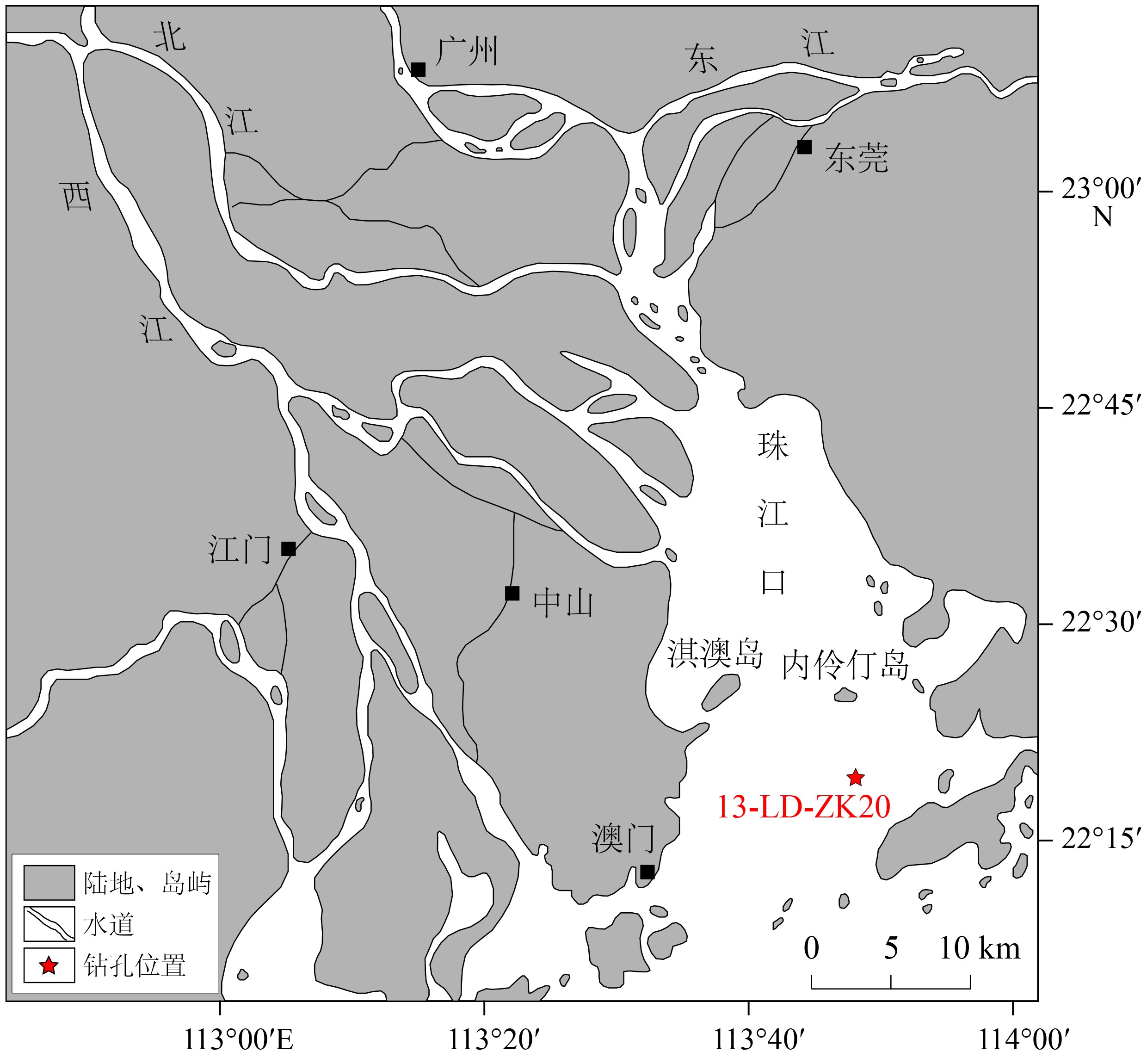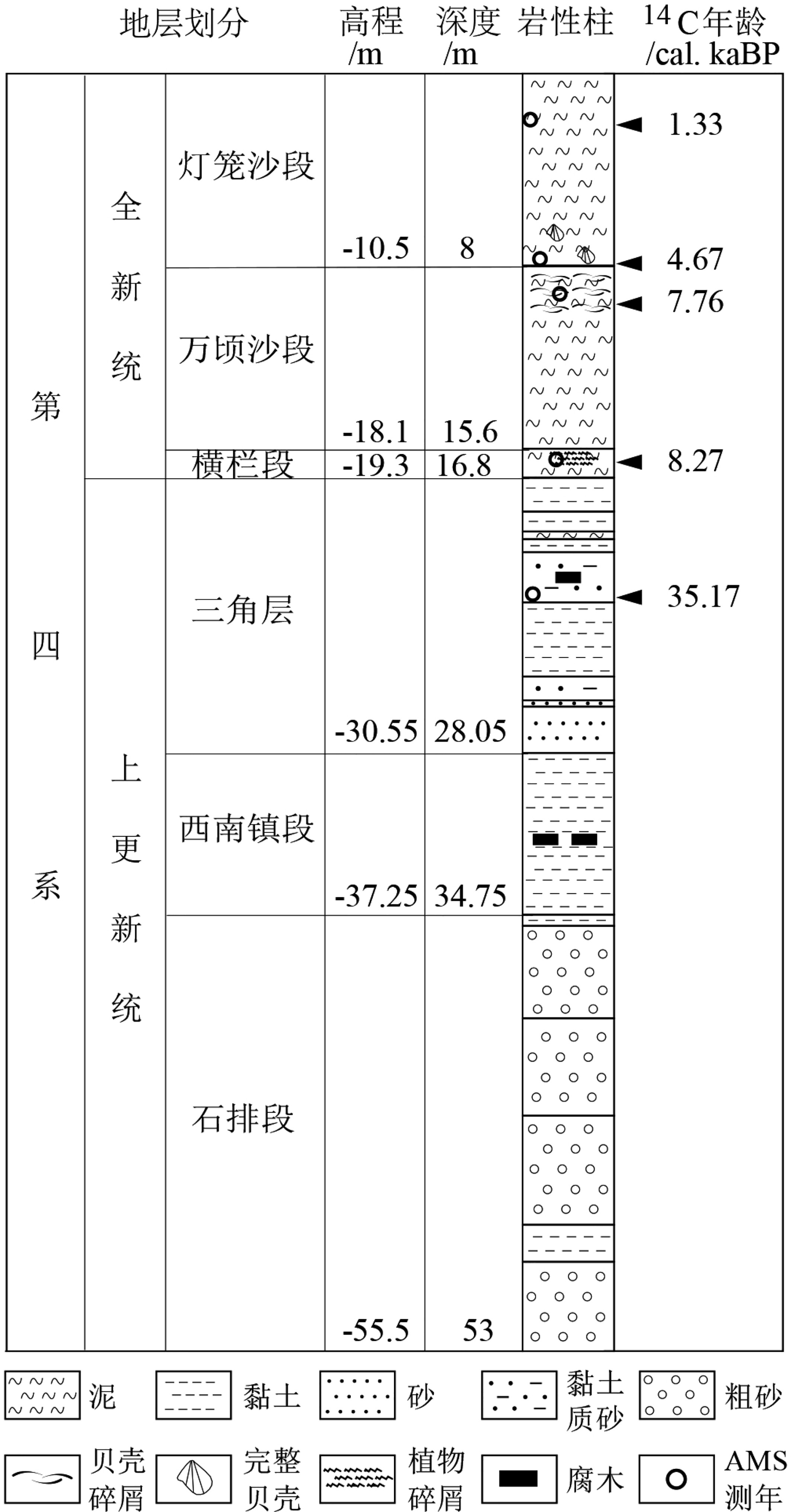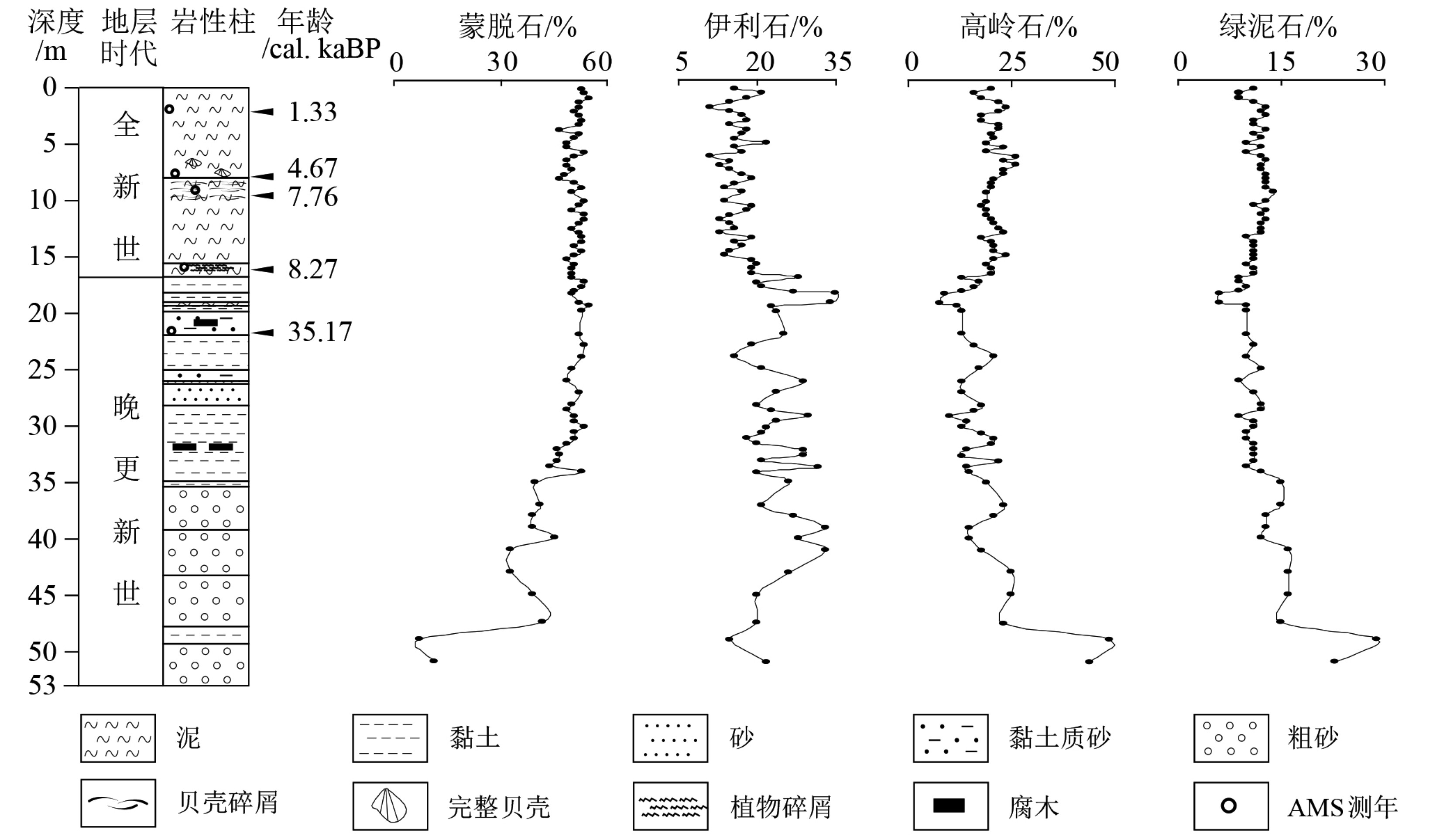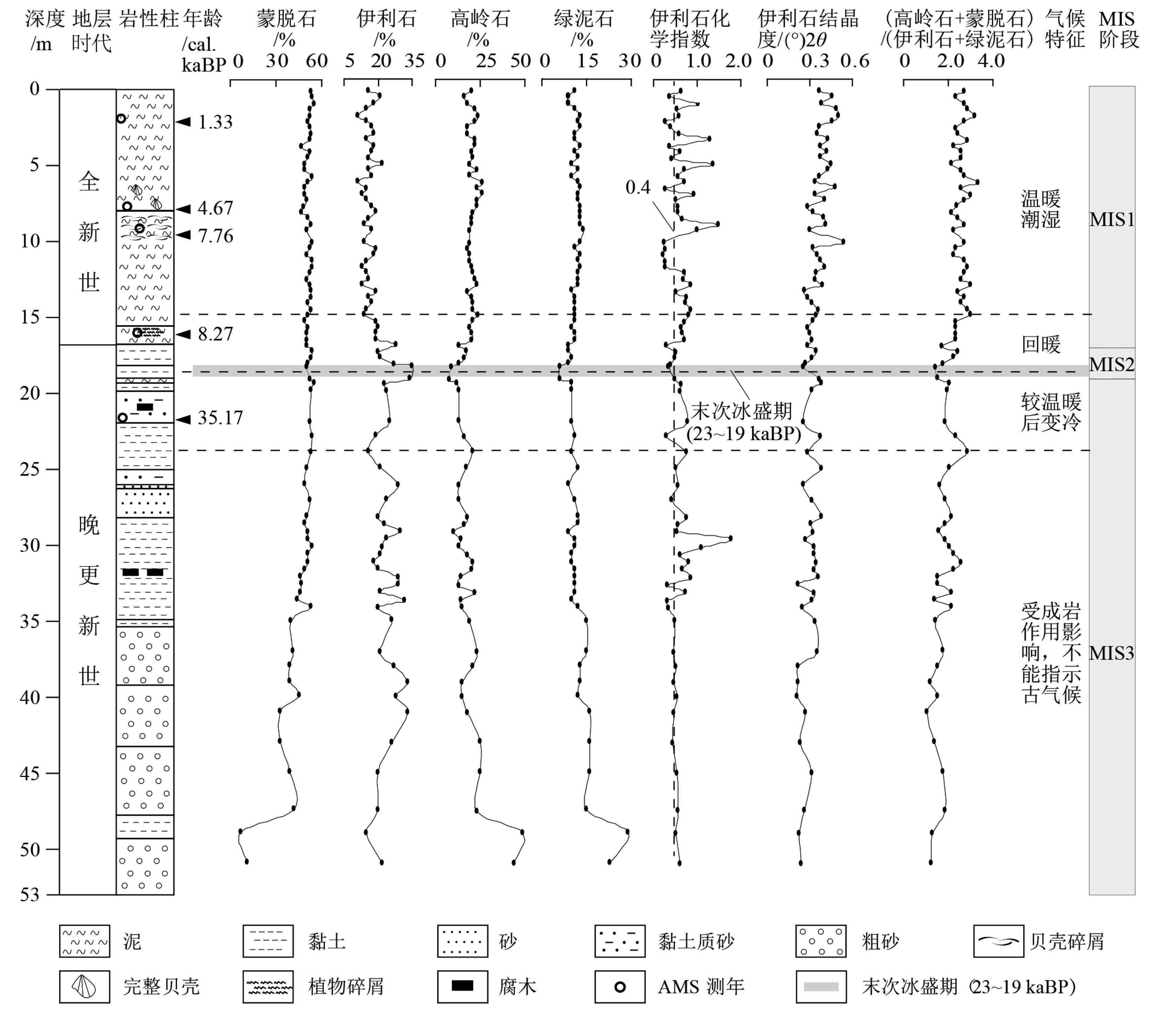Late Quaternary clay minerals in the inner Lingdingyang of the Pearl River Estuary, southern China: Implications for paleoclimate changes at the provenance
-
摘要: 黏土矿物组合和相对含量变化可反映源区地表风化过程,进而推断古气候的周期性变化,因此黏土矿物分析是古气候重建的重要手段之一。对珠江口内伶仃洋13-LD-ZK20钻孔晚第四纪沉积物中黏土矿物组成进行分析,结果显示黏土矿物主要为蒙脱石(含伊利石/蒙脱石无序混层),平均相对含量为49%,其次为伊利石、高岭石和绿泥石,平均相对含量分别为20%、19%和12%。伊利石化学指数较高(多数大于0.4),指示源区强烈的化学风化作用。珠江口内伶仃洋晚第四纪以来黏土矿物根据其相对含量变化和岩芯是否受成岩作用影响可分为4个阶段,指示西江源区气候总体暖-冷-暖的变化趋势。晚更新世第1阶段黏土矿物受成岩作用影响,不具古气候指示意义,第2阶段初期较为温暖,末期存在短期气候相对干冷阶段,可能与晚更新世末次冰盛期有关,第3阶段前期稍转暖。全新世(第3阶段后期和第4阶段)主要为温暖潮湿气候特征,并存在短期冷-暖波动。Abstract: Clay minerals are good indicators of paleoclimate changes , and therefore, clay mineral analysis is commonly used as a powerful tool for paleoclimate reconstruction. In this study, the assemblages and relative contents of clay minerals of the Late Quaternary sediments from the drill core 13-LD-ZK20 in the inner Lingdingyang of the Pearl River Estuary are analyzed. Our results suggest that the clay mineral assemblages are dominated by smectite on an average content of about 49% including illite-smectite mixed-layers clay mineral(R=0), followed by illite, kaolinite and chlorite on average of 20%, 19% and 12%, respectively. The high illite chemical weathering index is mostly greater than 0.4, which signify intense chemical weathering at the provenance. The Late Quaternary deposits of the region can be subdivided into four stages based on the composition of clay minerals and the diagenesis of sediments. It indicates a fluctuated paleoclimate pattern in the Xijiang drainage from warm, cold to warm again. Paleoclimate was unable to be reconstructed with clay minerals for the first stage of Late Pleistocene, due to strong diagenesis. In the second stage, it was warm in the beginning and turned cold by the end of the stage, most likely related to the Last Glacial Maximum. Then the paleoclimate slightly turned warmer in the early third stage. The paleoclimate in the Holocene was warm and humid with short periods of fluctuations.
-
构造迁移是指在一定的地球动力环境中,岩石圈或地壳在特定区域或阶段的构造活动及其相关的各种地质、地球物理、地球化学作用沿一定方向依次有规律的位移[1-2]。系统查明盆地或凹陷构造迁移特征,对于深入认识构造-沉积演化规律、系统评价潜在富烃凹陷及优选有利勘探方向至关重要。国内外大量学者针对不同类型盆地构造迁移的特征、成因机制及其动力学过程开展了大量富有成效的研究[3-4],并深入探讨了构造迁移对含油气盆地形成与演化、优质烃源岩发育、有利圈闭及油气藏分布等的影响[5-9]。
中国近海含油气盆地以中生代—新生代断陷盆地为主,构造迁移往往是多幕裂陷过程中不同裂陷幕的重要转换标志[10],并对优质烃源灶及油气资源的分布具有重要控制。例如,渤海湾盆地东部古近纪叠加太平洋板块俯冲方向变化及郯庐断裂走滑效应,渤东凹陷和庙西凹陷地层构成、控凹断层活动性以及沉积沉降中心发生从东向西、从南向北的构造迁移[11];东海盆地西湖凹陷晚始新世应力场从前平湖组沉积期的NW-SE向转为平湖组沉积期的NWW-SEE向,进而控制沉积中心从凹陷北部迁移至中部[12];珠江口盆地陆丰凹陷古近纪裂陷Ⅰ幕为陆丰南次洼的主裂陷幕、裂陷Ⅱ幕为陆丰北次洼的主裂陷幕,沉积沉降中心具有从南向北的迁移特征[13];北部湾盆地古新世裂陷期构造应力场发生了顺时针旋转,控制各凹陷沉积沉降中心具有波浪式定向性、汇聚型偏对称性等迁移特征[6]。
东海盆地丽水凹陷是中国海油在东海海域寻求储量替代或勘探突破的重要新领域之一。自1984年勘探至今,丽水凹陷相继钻探了24口井,在1997年发现丽水36-1气田以后未再有商业发现。近40年来,前人主要针对丽水凹陷构造特征及演化、沉积充填与源汇系统、烃源岩及生排烃史等方面开展了大量卓有成效的研究[14-21],而关于丽水凹陷构造迁移规律尚未见报道,对于其构造迁移的成因机制及对油气成藏的影响尚未有详尽阐述。笔者此次基于新采集的三维地震、钻井、古生物及有机地球化学数据,综合构造-地层格架、控凹主断层活动性及垂向演化、沉积沉降中心时空展布等地质信息,首次揭示丽水凹陷古新世构造及洼陷迁移规律,探讨丽水凹陷构造迁移的区域动力学背景及成因机制,并讨论了构造迁移对烃源岩及生烃潜力的影响,以期对深化丽水凹陷构造-沉积演化过程认识及油气勘探实践能有所裨益。
1. 区域地质概况
东海陆架盆地处于西太平洋板块、印-澳板块与欧亚板块的汇聚地带,是以晚白垩世—新生代充填为主的中生代—新生代叠合型含油气盆地[22-23],整体呈NNE向展布,总面积约4.28×105 km2;盆内隆坳相间配置,具有明显的“东西分带、南北分块”构造格局。丽水凹陷位于台北坳陷西南缘(图1),西邻闽浙隆起区,东以雁荡凸起与福州凹陷相隔,南北分别与台西盆地、椒江凹陷相接,整体呈NE-SW走向,为“东断西超”的脊状断陷[14, 17],可划分为丽水西次凹、丽水东次凹和灵峰低凸起等次级构造单元,总面积约
13000 km2,最大沉积厚度约11000 m,现今水深小于100 m。丽水凹陷构造演化从早到晚经历了4个阶段[15-17,23]:晚白垩世—古新世裂陷期(Tg-T80)、始新世拗陷期(T80-T40)、始新世末—渐新世抬升剥蚀期(T40-T20)和新近纪—第四纪整体沉降期(T20至现今),对应的沉积充填则经历了由陆相到海相的演变(图2)。钻井及区域地层对比揭示,裂陷期依次充填了上白垩统石门潭组陆相河流沉积、下古新统月桂峰组陆相三角洲-湖泊沉积、中—上古新统灵峰组和明月峰组三角洲-滨浅海相沉积;拗陷期依次充填了始新统瓯江组和温州组三角洲-滨浅海相沉积;受始新世末期的玉泉运动和渐新世末期的花港运动影响,区域上整体缺失了始新统平湖组和渐新统花港组;新近纪—第四纪大范围沉积了滨-浅海相或海陆过渡相的中新统龙井组、玉泉组、柳浪组以及上新统三潭组和更新统东海群(图2)。
受构造演化与沉积充填控制,丽水凹陷古新世断陷期发育了三套两类烃源岩,分别为月桂峰组湖相烃源岩、灵峰组及明月峰组陆源海相烃源岩。月桂峰组下—中段以棕黑色、深褐色和灰色泥岩夹薄层粉细砂岩为主,含有丰富的淡水绿藻类化石盘星藻,月桂峰组上段为浅灰色、灰色、暗灰色、黑灰色泥岩与浅灰色细—中粒砂岩不等厚互层,泥岩总有机碳含量(TOC)为0.53%~4.08%、平均为1.74%,生烃潜量(S1+S2)为0.13~15.29 mg/g、平均为2.70 mg/g,总体为中等—很好烃源岩,有机质类型以II1-II2型为主。灵峰组以巨厚的灰色、暗灰色、黑灰色泥岩、粉砂质泥岩为主,夹薄层浅灰色含钙粉砂岩、细砂岩和少量薄层钙质细砂岩,泥岩总有机碳含量为0.50%~4.12%,平均为1.25%,生烃潜力为0.07~9.10 mg/g,平均为1.83 mg/g,以中等烃源岩为主,有机质类型以Ⅲ型为主,含少量II2型。明月峰组具有典型的“粗-细-粗”沉积旋回,下部主要为浅灰色—褐灰色钙质粉砂岩和细砂岩,上部为浅灰色、灰白色含砾粗砂岩、中砂岩、细砂岩、粉砂岩与灰色、褐灰色泥岩呈不等厚互层,总有机碳含量0.51%~5.97%、平均1.07%,生烃潜力为0.23~16.50mg/g,平均为1.75 mg/g,以中等烃源岩为主,有机质类型以Ⅲ型为主。明月峰组陆源海相烃源岩现今镜质体反射率(Ro)主体在0.7%以下,处于未熟—低熟演化阶段,生烃潜力有限。前人基于有机地球化学、生排烃数值模拟及区域地质研究,普遍认为下古新统月桂峰组湖相烃源岩为丽水凹陷主力烃源岩[18-20];而油气来源分析表明,丽水36-1气田的天然气和凝析油来源于灵峰组烃源岩,或由灵峰组及月桂峰组烃源岩共同供源[25-26],因此灵峰组为丽水凹陷另一套重要烃源岩。
丽水凹陷油气显示及油气层主要位于古新统,始新统中下部瓯江组、温州组可见油气显示,区域上主要发育3套储盖组合[20]:下部组合以月桂峰组扇三角洲和辫状河三角洲砂岩为储集层,以灵峰组厚层浅海相泥岩为良好区域盖层;中部组合以灵峰组上段三角洲砂岩、明月峰组下段三角洲及海底扇砂岩为储集层,以明月峰组中段浅海相泥岩为区域盖层;上部组合以明月峰组上段和瓯江组三角洲-滨海相砂岩为储集层,以温州组中下部泥岩为区域盖层,以明月峰组上部和瓯江组泥岩为局部盖层。
2. 丽水凹陷构造迁移特征
2.1 构造-地层格架特征
本次研究基于二维、三维地震数据,通过井震联合标定及地震精细解释,对丽水凹陷古新统关键地层界面和主要控凹断裂开展综合识别与区域追踪,构建了丽水凹陷古新统构造-地层格架(图3)。
在垂向上,古新统不同层系几何形态及地震波组特征存在明显差异。古新统下部月桂峰组主要分布于洼陷内,而在丽水东次凹和丽水西次凹斜坡区均可见明显削截;其整体呈楔形,受边界断层控制作用明显,同时洼内次级断裂使得楔形充填结构复杂,洼陷内地震相主要呈现出低频、连续、强反射或中—低频、中等—好连续性、中等振幅反射特征。中古新统灵峰组为整个丽水凹陷内最厚的一套沉积层,在控凹断裂强烈控制下,形成巨厚的楔形沉积,覆盖范围较月桂峰组有所增大,在丽水东次凹和丽水西次凹斜坡区也见明显削截,地震相主要为中—低频、中等—好连续性、中—弱振幅反射。而古新统上部明月峰组整体呈碟形,断控作用明显减弱,地层超覆于灵峰低凸起之上,断拗转换及均一化特征明显,丽水西次凹和丽水东次凹相互连通形成统一凹陷,地震相主要呈现中—高频、较好连续性、变振幅反射特征。
从横向上看,古新统(T100—T80)丽水东次凹和丽水西次凹均受控于东侧边界主断层控制的“东断西超”箕状断陷(图3),其中丽水西次凹基底最大埋 深
11300 m,古新统最大厚度8300 m,呈“薄月桂峰组、厚灵峰组”充填结构(图4a、b);而丽水东次凹基底最大埋深7400 m,古新统最大厚度4400 m,地层充填结构与丽水西次凹明显不同,呈现出“厚月桂峰组、薄灵峰组”充填结构(图4a、b)。由此可知,在月桂峰组沉积期,丽水西次凹和丽水东次凹独立发育,二者断陷作用强度基本相当,丽水东次凹断陷强度略大于丽水西次凹;而到了灵峰组沉积期,丽水西次凹断陷作用强度明显大于丽水东次凹,沉积了巨厚的灵峰组,沉积沉降中心已迁移至丽水西次凹;至明月峰组沉积期,丽水西次凹和丽水东次凹相互连通形成统一凹陷,沉积沉降中心继承性发育并位于丽水西次凹。2.2 控凹断层发育与演化特征
丽水凹陷内发育两条主控断裂,分别为丽西断裂和丽东断裂,其差异性活动控制了丽水西次凹和丽水东次凹古新世的构造演化过程。
丽西断裂是丽水西次凹和灵峰低凸起的边界断裂,平面延伸距离约140 km,整体呈“S”形展布,其中北段和南段为NE走向,中段呈NNE走向;丽西断裂不同分段的剖面形态存在一定差异,其北段为铲式正断层,伴生断裂不发育,而南段也为铲式正断层,但倾角相对北段变缓,且在古新统上部及始新统内部发育大量次级断裂,与主断裂组合形成了似花状构造样式,显示出丽西断裂局部具有扭动性质。丽东断裂是丽水东次凹和雁荡凸起的边界断裂,平面延伸距离约200 km,整体呈NE-SW向展布;剖面上主要为铲式正断层,局部分段发育的次级断裂与主断裂组合形成“Y”字形,显示以伸展性质为主。
在断裂活动性方面(图5),丽西断裂在古新世经历了活动性急剧增强再减弱的过程,其中月桂峰组沉积期断层活动速率为143~408 m/Ma,平均284 m/Ma;灵峰组沉积期断层活动速率为457~
1915 m/Ma,平均1284 m/Ma;明月峰组沉积期断层活动速率减弱至93~280 m/Ma,平均206 m/Ma。丽东断裂在古新世也经历了活动性急剧增强再减弱的过程,其中月桂峰组沉积期断层活动速率为153~513 m/Ma,平均321 m/Ma;灵峰组沉积期活动速率为262~690 m/Ma,平均为419 m/Ma;明月峰组沉积期断层活动性减弱至17~124 m/Ma,平均为80 m/Ma(图5)。两条主干断裂活动性虽然具有相似的演化过程,但不同时期的相对强弱关系存在转换:月桂峰组沉积期,丽西断裂整体活动性略小于丽东断裂,而灵峰组沉积期两者活动性发生了转换,丽西断裂垂向活动性远大于丽东断裂,至明月峰组沉积期丽西断裂活动性仍然较大,但这种差异已缩小。由此可知,从古新世早期至古新世中晚期,两条控凹断层活动性的差异演化控制了丽水凹陷沉积沉降中心自东向西迁移。2.3 沉积沉降中心迁移特征
丽水凹陷古新世沉积沉降中心具有自东向西、由孤立向统一的迁移规律(图5)。古新世早期月桂峰组沉积期,受控于基底先存形态与边界控凹断裂的分段性、差异化强烈活动,丽水凹陷的东次凹和西次凹均发育多个规模较小的局部沉积中心,呈NE向展布(图4a),紧邻控洼断层下降盘,平面上呈孤立状、强分隔性展布,丽水东次凹的月桂峰组厚度最大,最大厚度
2200 m,而丽水西次凹最大厚度1900 m;该阶段丽水东次凹最大厚度大于丽水西次凹,表明丽水凹陷沉积沉降中心位于丽水东次凹的东北部。古新世中期灵峰组沉积期(图4b),丽水凹陷沉积沉降中心已迁移至丽水西次凹,沉积中心具有一定继承性,但其规模均明显增大,并由孤立趋于连通,丽水西次凹沉积规模明显大于丽水东次凹;此时丽水西次凹最大厚度位于北部,其灵峰组最大厚度约5000 m,丽水东次凹最大厚度同样位于北部,其灵峰组最大厚度约1700 m,沉积中心自东向西迁移的同时,沉降沉降中心长轴方向也由NE向转变为NNE向,表明丽西断裂和丽东断裂的分段控制作用急剧减弱。古新世晚期明月峰组沉积期(图4c),丽水凹陷沉积沉降中心仍位于丽水西次凹,丽水西次凹和丽水东次凹早期分隔的沉积中心连通统一,规模进一步增大,并趋于均一化,整体沿NNE向展布,断控作用明显降低,断拗转换特征明显;此时丽水西次凹明月峰组最大沉积厚度约1800 m,丽水东次凹明月峰组最大沉积厚度约1500 m。综合构造-地层格架、控凹断层活动性与演化、沉积沉降中心迁移特征可知,丽水凹陷古新世断陷-沉积中心“自东向西”发生了构造迁移,即古新世早期断陷-沉积中心位于丽水东次凹,古新世中期断陷-沉积中心迁移至丽水西次凹,古新世晚期断陷-沉积中心继承性发育。
3. 构造迁移成因探讨
丽水凹陷古新世构造迁移是东海陆架盆地中生代—新生代构造演化的组成部分,是古太平洋板块与洋中脊俯冲在东海盆地内的构造响应。
就东海陆架盆地而言,其中生代经历特提斯构造域向太平洋构造域的转变,自侏罗纪以来,先后经历了大陆边缘拗陷期(侏罗纪)、泛裂陷期(白垩纪至古新世)、裂陷迁移期(始新世至今)[23, 27-29]。大陆边缘拗陷期呈拗陷型盆地,地层沉积不受断层控制,沉积中心主要分布于现今福州凹陷,即丽水凹陷东部;而泛裂陷期断控作用增强,丽水、钓北和福州等凹陷内断裂发育、断裂控沉积作用增强,其中中生界沉积中心位于中部福州凹陷及邻区,古近系沉积中心位于西部丽水凹陷及邻区,即沉积中心发生了自东向西的迁移;裂陷迁移期,盆地主要控凹断裂在泛裂陷期活动断裂的基础上由西向东变化,控制了沉积中心不断向东迁移,即从丽水凹陷所在的西部坳陷带向西湖凹陷所在的东部坳陷带迁移,并进一步向东迁移至冲绳海槽附近[28-29]。东海陆架盆地构造演化过程受控于(古)太平洋板块后撤式俯冲、印度板块向欧亚板块俯冲碰撞的远程效应以及菲律宾海板块的楔入[30-33]。
丽水凹陷古新世构造迁移是东海陆架盆地泛裂陷期沉积中心由福州凹陷向西部丽水凹陷迁移演化的组成部分,是多个板块相互作用的结果。然而,古新世早于印度板块与欧亚板块最初的“软碰撞”时间(约50 Ma)[30],更早于菲律宾海板块向欧亚板块的俯冲时间(约23.3 Ma)[34],因此丽水凹陷构造迁移最可能的控制因素是(古)太平洋板块俯冲。古新世东亚地区主要构造事件是古太平洋板块完全俯冲于东亚大陆之下,太平洋板块取而代之开始俯冲以及古太平洋板块与太平洋板块间的洋中脊俯冲[35],从时间角度考虑,丽水凹陷古新世构造迁移与这一区域地质事件相匹配。除丽水凹陷之外,笔者在东海盆地北部长江坳陷古新世也发现了这一迁移特征存在的可能,虽然限于井震资料尚不能完全证实,但也说明构造迁移不仅局限于丽水凹陷,而且很可能是东海盆地西部坳陷带的整体规律,是古太平洋板块以及大洋板块间的洋中脊俯冲在东海盆地内的具体响应。
4. 构造迁移对烃源岩及生烃潜力的影响
4.1 对烃源岩规模及分布的影响
构造-沉积作用控制了烃源岩的空间展布和地球化学特征[36-37]。丽水凹陷古新世断陷-沉积中心“自东向西”迁移控制了凹陷可容纳空间的规律性变化及沉积体系发育与展布,进而影响了月桂峰组湖相烃源岩、灵峰组陆源海相烃源岩在丽水凹陷不同次凹内差异分布。
4.1.1 月桂峰组湖相烃源岩
丽水凹陷古新世早期月桂峰组沉积期处于强烈断陷Ⅰ幕,丽水东次凹断陷强度更大,为整个丽水凹陷的沉积沉降中心。受西部闽浙隆起、东部雁荡凸起及凹陷内部灵峰低凸起供源,丽水凹陷各次洼从陡坡带至缓坡带主要发育陡坡扇/扇三角洲—半深湖-深湖—滨浅湖-辫状河三角洲沉积组合(图6a);而半深湖-深湖亚相主要发育在深洼区靠近陡坡带一侧。强烈断陷有利于发育半深湖-深湖相沉积环境,从而易于形成厚层细粒湖相泥岩、稳定的水体分层、优越的有机质保存条件,利于优质湖相烃源岩的发育。月桂峰组沉积期,丽水凹陷各个深洼区处于欠补偿状态,发育半深-深湖亚相优质烃源岩,其平面分布与断陷湖盆沉积沉降中心位置一致。
基于钻井及地震相综合识别,丽水东次凹和丽水西次凹均不同规模发育半深湖-深湖亚相,在地震上表现为低频连续中—强振幅反射,其中丽水东次凹半深湖-深湖亚相面积为186 km2,最大沉积厚度
1950 m,而丽水西次凹北段半深湖-深湖亚相面积103 km2,最大沉积厚度1840 m,丽水西次凹南段半深湖-深湖亚相面积92 km2,最大沉积厚度1230 m。位于丽水东次凹的W1井揭示出月桂峰组下段176 m深灰色厚层泥岩夹薄层粉砂岩,泥地比达86%,泥岩总有机碳为1%~3%,平均为1.8%,超过75%的样品中TOC值≥1.0%,生烃潜量主体为2~6 mg/g,平均为3.2 mg/g,总体为好—很好湖相烃源岩;而位于丽水西次凹的W2井揭示了月桂峰组264.3 m厚层褐灰色泥岩夹薄层粉砂质泥岩,泥地比为100%,泥岩总有机碳主体为0.5%~1%,平均为0.97%,超75%的样品中TOC值≤1.0%,生烃潜量为1.5~3 mg/g,平均为2.3 mg/g,整体为中等湖相烃源岩(图7a)。4.1.2 灵峰组陆源海相烃源岩
丽水凹陷古新世中期灵峰组沉积期处于强烈断陷Ⅱ幕,该时期丽水凹陷区域沉积沉降中心迁移至丽水西次凹。受区域海侵影响,灵峰组为强断陷背景下的海相沉积,受闽浙隆起、雁荡凸起及灵峰低凸起共同供源,凹陷内主要发育陡坡扇/扇三角洲-滨浅海-辫状河三角洲沉积组合,洼陷中心沉积了巨厚的浅海相泥岩(图6b)。基于丽水凹陷16口钻井统计,丽水西次凹灵峰组烃源岩有机质丰度优于丽水东次凹,尤其以丽水西次凹南段有机质丰度最高。在丽水东次凹,灵峰组泥岩总有机碳主体为0.5%~1.5%,平均为0.96%,生烃潜量主体为0.6~2 mg/g,平均为1.4 mg/g,为中等—好烃源岩;在丽水西次凹北段,灵峰组泥岩总有机碳主体为0.8%~1.5%,平均为1.2%,生烃潜量主体为1.2~2.5 mg/g,平均为2.1 mg/g,为中等—好烃源岩;在丽水西次凹南段,灵峰组泥岩总有机碳主体为1%~2%,平均为1.4%,超过75%的样品值≥1.0%,生烃潜量为1~3 mg/g,平均为1.9 mg/g,为中等—好烃源岩,少量为很好烃源岩;其有机质类型均为Ⅱ2—Ⅲ型,显微组分以镜质组为主(图7b)。
陆源海相烃源岩的发育受控于陆源有机质的输入及保存条件。灵峰组沉积期,丽水西次凹断陷作用强烈,为大型陆源碎屑的注入提供了可容纳空间,受西部闽浙隆起区大型物源供给,在西部缓坡带发育大型辫状河三角洲沉积体系,而近洼陷区更有利于陆源有机质的保存。从灵峰组不同沉积相带泥岩的总有机碳来看,三角洲前缘和靠近三角洲的浅海相有机质丰度较高,其TOC主体为1%~2%,为好烃源岩;而滨海和远离三角洲的浅海TOC主体为0.5%~1%,为中等烃源岩。因此,三角洲前缘和近三角洲的浅海为灵峰组陆源海相好烃源岩的有利沉积相带。
综上可知,丽水凹陷受控于古新世断陷-沉积中心“自东向西”迁移,对于月桂峰组湖相烃源岩而言,丽水东次凹湖相烃源岩的规模、品质均明显优于丽水西次凹;而对于灵峰组陆源海相烃源岩而言,丽水西次凹陆源海相烃源岩的规模、品质均明显优于丽水东次凹,尤其以丽水西次凹南段的灵峰组烃源岩品质最好。
4.2 对油气生烃潜力的影响
构造迁移对丽水凹陷两套烃源岩的热演化程度及油气资源的分布也具有明显控制作用。随着古新世断陷-沉积中心“自东向西”迁移,导致丽水西次凹强烈沉降、整体埋深大,烃源岩的热演化程度与丽水东次凹更高。从丽水凹陷月桂峰组和灵峰组烃源岩镜质体反射率(Ro)模拟结果来看,两套烃源岩热演化程度整体表现出“西高东低、北高南低”,不同洼陷、不同层系烃源岩成熟度存在差异,即不同洼陷烃源灶规模及生烃潜力存在差异。月桂峰组、灵峰组烃源岩成熟度从洼陷中心向凹陷边缘呈环带状降低,丽水东次凹和丽水西次凹主体均进入成熟阶段(Ro>0.5%),凹陷中心已进入高熟—过熟阶段(Ro>1.3%),为凝析油、湿气、干气生成阶段,而凹陷周边以成熟阶段为主,为液态烃生成阶段。整体而言,无论是月桂峰组还是灵峰组,丽水西次凹烃源岩热演化程度高于丽水东次凹(图8)。
进一步利用Trinity软件模拟了丽水凹陷月桂峰组、灵峰组烃源岩的排烃潜力。从烃源岩排烃强度来看,丽水东次凹月桂峰组烃源岩排烃强度为0~0.27亿方/km2,均值为0.04亿方/km2,灵峰组烃源岩排烃强度为0~0.05亿方/km2,均值为0.01亿方/km2;丽水西次凹月桂峰组烃源岩排烃强度0~0.79亿方/km2,均值为0.05亿方/km2;灵峰组烃源岩排烃强度为0~0.09亿方/km2,均值为0.03亿方/km2(图9)。对不同层系而言,月桂峰组油气兼生,是主要的排烃层系,而灵峰组以排气为主;丽水凹陷排油量100%来自月桂峰组,排气量60.3%来自月桂峰组,39.7%来自灵峰组。
4.3 对有利油气勘探方向的影响
构造迁移影响了烃源岩发育规模与生烃潜力,进而导致丽水凹陷两个次凹的油气相态、资源规模和油气富集层系的差异。仅从烃源灶的规模来看,丽水西次凹月桂峰组和灵峰组烃源灶的规模均明显大于丽水东次凹,因此丽水西次凹资源规模大于丽水东次凹。具体来说,丽水东次凹月桂峰组半深湖亚相烃源岩规模较大、成熟度高、排烃强度较大,而灵峰组烃源岩规模较小、排烃强度小,因此其油气勘探应聚焦以月桂峰组烃源灶为主的含油气系统,以找油为主;丽水西次凹月桂峰组半深湖亚相烃源岩规模小于东次凹,但叠加了灵峰组规模较大、且高成熟度的陆源海相烃源岩,因此其油气勘探应综合考虑以月桂峰组烃源灶为主和以灵峰组烃源灶为主的两套含油气系统,油气兼生,以气为主,找气潜力较大,尤其是月桂峰组烃源灶和灵峰组烃源灶叠合的区带,供烃条件最为有利。此外,丽水西次凹两套烃源岩埋深大,发育超压,具有较高的供烃动力,在综合考虑输导体系、储盖组合的基础上,应聚焦多层系立体勘探;而丽水东次凹月桂峰组湖相烃源岩埋深较西次凹浅,供烃动力较低,且受灵峰组厚层浅海相泥岩垂向封盖,因此以源内或近源层系为主要勘探目的层。
5. 结论
(1)丽水凹陷古新世断陷-沉积中心发生“自东向西”迁移,即区域沉积沉降中心在古新世早期位于丽水东次凹、古新世中期迁移至丽水西次凹、古新世晚期继承性发育;丽水东次凹呈“厚月桂峰组、薄灵峰组”充填结构,而丽水西次凹为“薄月桂峰组、厚灵峰组”充填结构。
(2)丽水凹陷古新世构造迁移是东海陆架盆地由大陆边缘坳陷向泛裂陷演化过程中引起主要活动断裂及沉积沉降中心向西迁移的结果,其动力来源最可能是古新世古太平洋板块以及大洋板块间的洋中脊俯冲。
(3)受构造迁移影响,丽水东次凹月桂峰组湖相烃源岩规模较大,品质较好,排烃强度较大,而丽水西次凹发育规模较小,成熟度较高的月桂峰组湖相烃源岩,并叠加灵峰组规模较大、高成熟度的陆源海相烃源岩;丽水东次凹应聚焦以月桂峰组烃源灶为主的含油气系统进行勘探,以找油为主,而丽水西次凹油气勘探应综合考虑月桂峰组或灵峰组两套烃源灶,且油气兼生、以气为主。
-
图 3 13-LD-ZK20钻孔典型样品X射线衍射图
样品13-LD-ZK20-34,取样深度13.6~13.2 m。Chl:绿泥石,Ill:伊利石,Kao:高岭石,Mnt:蒙脱石。
Figure 3. X-ray diffractograms of a representative sample of clay minerals
Sample 13-LD-ZK20-34 in depth of 13.6~13.2 m. Chl, Ill, Kao and Mnt are abbreviations for chlorite, illite, kaolinite and montmorillonite, respectively.
-
[1] Zhang Q, Xiao M Z, Singh V P, et al. Regionalization and spatial changing properties of droughts across the Pearl River basin, China [J]. Journal of Hydrology, 2012, 472-473: 355-366. doi: 10.1016/j.jhydrol.2012.09.054
[2] Liu Y T, Song C H, Meng Q Q, et al. Paleoclimate change since the Miocene inferred from clay-mineral records of the Jiuquan Basin, NW China [J]. Palaeogeography, Palaeoclimatology, Palaeoecology, 2020, 550: 109730. doi: 10.1016/j.palaeo.2020.109730
[3] Chamley H. Clay Sedimentology[M]. Berlin: Springer-Verlag, 1989: 1-621.
[4] Dera G, Pellenard P, Neige P, et al. Distribution of clay minerals in Early Jurassic Peritethyan seas: Palaeoclimatic significance inferred from multiproxy comparisons [J]. Palaeogeography, Palaeoclimatology, Palaeoecology, 2009, 271(1-2): 39-51. doi: 10.1016/j.palaeo.2008.09.010
[5] Kemp S J, Ellis M A, Mounteney I, et al. Palaeoclimatic implications of high-resolution clay mineral assemblages preceding and across the onset of the Palaeocene–Eocene Thermal Maximum, North Sea Basin [J]. Clay Minerals, 2016, 51(5): 793-813. doi: 10.1180/claymin.2016.051.5.08
[6] Song Y G, Wang Q S, An Z S, et al. Mid-Miocene climatic optimum: Clay mineral evidence from the red clay succession, Longzhong Basin, Northern China [J]. Palaeogeography, Palaeoclimatology, Palaeoecology, 2017, 512: 46-55. doi: 10.1016/j.palaeo.2017.10.001
[7] Wang Q S, Song Y G, Li Y, et al. The climate changes from clay minerals recorded by the Zhuanglang red clay on the western Chinese loess Plateau [J]. Acta Geologica Sinica (English Edition), 2018, 92(S2): 109-112.
[8] Liu Z F, Colin C, Huang W, et al. Clay minerals in surface sediments of the Pearl River drainage basin and their contribution to the South China Sea [J]. Chinese Science Bulletin, 2007, 52(8): 1101-1111. doi: 10.1007/s11434-007-0161-9
[9] 时翠, 甘华阳, 马胜中, 等. 晚更新世以来内伶仃洋河口湾的地层层序和沉积演化[J]. 海洋地质前沿, 2015, 31(10):8-18 SHI Cui, GAN Huayang, MA Shengzhong, et al. Late Quaternary evolution and sequence stratigraphy of the Lingdingyang Eatuary in south China [J]. Marine Geology Frontiers, 2015, 31(10): 8-18.
[10] 马胜中, 倪玉根, 林进清, 等. 1: 5万珠江口内伶仃洋海洋区域地质调查(试点)2013年度成果报告[R]. 广州: 广州海洋地质调查局, 中国, 2013: 1-128. MA Shengzhong, NI Yugen, LIN Jinqing, et al. Annual report of marine regional geological survey (pilot project) of inner Lingdingyang in the Pearl River Estuary (1: 50000) in 2013[R]. Guangzhou: Guangzhou Marine Geological Survey, China, 2013: 1-128.
[11] Brown T A, Nelson D E, Mathewes R W, et al. Radiocarbon dating of pollen by accelerator mass spectrometry [J]. Quaternary Research, 1989, 32(2): 205-212. doi: 10.1016/0033-5894(89)90076-8
[12] Holtzapffel T. Les minéraux argileux: préparation, analyse diffractométrique et determination [J]. Société Géologique du Nord, 1985, 12: 1-136.
[13] Soleimani B. Paleoclimate reconstruction during Pabdeh, Gurpi, Kazhdumi and Gadvan formations (Cretaceous-Tertiary) based on clay mineral [J]. International Journal of Civil and Environmental Engineering, 2009, 1(2): 59-63.
[14] Chaudhri A R, Singh M. Clay minerals as climate change indicators-a case study [J]. American Journal of Climate Change, 2012, 1(4): 231-239. doi: 10.4236/ajcc.2012.14020
[15] Fagel N, Boski T, Likhoshway L, et al. Late Quaternary clay mineral record in Central Lake Baikal (Academician Ridge, Siberia) [J]. Palaeogeography, Palaeoclimatology, Palaeoecology, 2003, 193(1): 159-179. doi: 10.1016/S0031-0182(02)00633-8
[16] Lamy F, Hebbeln D, Wefer G. High-resolution marine record of climatic change in mid-latitude Chile during the Last 28, 000 years based on Terrigenous sediment Parameters [J]. Quaternary Research, 1999, 51(1): 83-93. doi: 10.1006/qres.1998.2010
[17] Esquevin J. Influence de la composition chimique des illites surcristallinite [J]. Bulletin du Centre de Recherches Rau-SNPA, 1969, 3(1): 147-153.
[18] Biscaye P E. Mineralogy and sedimentation of recent deep-sea clay in the atlantic ocean and adjacent seas and oceans [J]. GSA Bulletin, 1965, 76(7): 803-832. doi: 10.1130/0016-7606(1965)76[803:MASORD]2.0.CO;2
[19] Robert C, Kennett J P. Antarctic subtropical humid episode at the Paleocene-Eocene boundary: Clay-mineral evidence [J]. Geology, 1994, 22(3): 211-214. doi: 10.1130/0091-7613(1994)022<0211:ASHEAT>2.3.CO;2
[20] Hong H L, Li Z H, Xue H J, et al. Oligocene clay mineralogy of the Linxia Basin: Evidence of Palaeoclimatic evolution subsequent to the initial-stage uplift of the Tibetan Plateau [J]. Clays and Clay Minerals, 2007, 55(5): 491-503. doi: 10.1346/CCMN.2007.0550504
[21] Wang C W, Hong H L, Song B W, et al. The early-Eocene climate optimum (EECO) event in the Qaidam basin, northwest China: clay evidence [J]. Clay Minerals, 2011, 46(4): 649-661. doi: 10.1180/claymin.2011.046.4.649
[22] Rateev M A, Gorbunova Z N, Lisitzyn A P, et al. The distribution of clay minerals in the oceans [J]. Sedimentology, 1969, 13(1-2): 21-43. doi: 10.1111/j.1365-3091.1969.tb01119.x
[23] Thiry M. Palaeoclimatic interpretation of clay minerals in marine deposits: an outlook from the continental origin [J]. Earth-Science Reviews, 2000, 49(1-4): 201-221. doi: 10.1016/S0012-8252(99)00054-9
[24] Shen X Y, Wan S M, France-Lanord C, et al. History of Asian Eolian input to the Sea of Japan since 15 Ma: Links to Tibetan uplift or global cooling? [J]. Earth and Planetary Science Letters, 2017, 474: 296-308. doi: 10.1016/j.jpgl.2017.06.053
[25] 吴文中, 赵焕庭. 从沉积物的矿物分析论珠江河口湾伶仃洋的泥沙来源[J]. 热带海洋, 1982, 1(2):3-16 WU Wenzhong, ZHAO Huanting. On silt sources of Lingdingyang of the Zhujiang (Pearl River) Estuary by means of mineralogical analyses of the sediments [J]. Tropic Oceanology, 1982, 1(2): 3-16.
[26] Singer A. The paleoclimatic interpretation of clay minerals in soils and weathering profiles [J]. Earth-Science Reviews, 1980, 15(4): 303-326. doi: 10.1016/0012-8252(80)90113-0
[27] Velde B B, Meunier A. The Origin of Clay Minerals in Soils and Weathered Rocks[M]. Berlin: Springer, 2008: 1-403.
[28] Shi Y F, Yu G, Liu X D, et al. Reconstruction of the 30-40 ka BP enhanced Indian monsoon climate based on geological records from the Tibetan Plateau [J]. Palaeogeography, Palaeoclimatology, Palaeoecology, 2001, 169(1-2): 69-83. doi: 10.1016/S0031-0182(01)00216-4
[29] Yang B, Shi Y F, Braeuning A, et al. Evidence for a warm-humid climate in arid northwestern China during 40-30 ka BP [J]. Quaternary Science Reviews, 2004, 23(23-24): 2537-2548. doi: 10.1016/j.quascirev.2004.06.010
[30] 刘志飞, 李夏晶, COLIN C, 等. 南海北部末次冰盛期以来高分辨率黏土矿物记录及其时间序列物源区分析[J]. 科学通报, 2010, 55(35):4058-4068 doi: 10.1007/s11434-010-4149-5 LIU Zhifei, LI Xiajing, COLIN C, et al. A high-resolution clay mineralogical record in the northern South China Sea since the Last Glacial Maximum, and its time series provenance analysis [J]. Chinese Science Bulletin, 2010, 55(35): 4058-4068. doi: 10.1007/s11434-010-4149-5
[31] 王晓静, 王建华, 曹玲珑, 等. 广州地区晚第四纪孢粉气候研究[J]. 中山大学学报: 自然科学版, 2010, 49(3):113-121 WANG Xiaojing, WANG Jianhua, CAO Linglong, et al. Late Quaternary pollen records and climate significance in Guangzhou [J]. Acta Scientiarum Naturalium Universitatis Sunyatseni, 2010, 49(3): 113-121.
[32] 郑卓, 王建华. 珠江三角洲北部晚第四纪孢粉植物群的古环境意义[J]. 热带海洋, 1998, 17(3):1-9 ZHENG Zhuo, WANG Jianhua. Paleoenvironmental significance of Late Quaternary pollen flora in northern Zhujiang river delta [J]. Tropical Oceanology, 1998, 17(3): 1-9.
[33] 施雅风. 中国第四纪冰川新论[M]. 上海: 上海科学普及出版社, 2011: 1-213. SHI Yafeng. New Understanding of Quaternary Glaciations in China[M]. Shanghai: Shanghai Popular Science Press, 2011: 1-213.
[34] Cui Z J, Yang J F, Liu G N, et al. Discovery of Quaternary glacial evidence of Snow Mountain in Taiwan, China [J]. Chinese Science Bulletin, 2000, 45(6): 566-571. doi: 10.1007/BF02887108
[35] 杨作升. 黄河、长江、珠江沉积物中粘土的矿物组合、化学特征及其与物源区气候环境的关系[J]. 海洋与湖沼, 1988, 19(4):336-346 YANG Zuosheng. Mineralogical assemblages and chemical characteristics of clays from sediments of the Huanghe, Changjiang, Zhujiang rivers and their relationship to the climate environment in their sediment source areas [J]. Oceanologia et Limnologia Sinica, 1988, 19(4): 336-346.
[36] Huang Z G, Zhang W Q. The cooling fluctuation events during Holocene in the tropical zone of China [J]. Journal of Geographical Sciences, 2000, 12(1): 91-98.
[37] Wang N L, Yao T D, Thompson L G, et al. Evidence for cold events in the early Holocene from the Guliya ice core, Tibetan Plateau, China [J]. Chinese Science Bulletin, 2002, 47(17): 1422-1427. doi: 10.1360/02tb9313
[38] 黄镇国, 张伟强. 历史时期中国热带的气候波动与自然灾害[J]. 自然灾害学报, 2004, 13(2):58-63 doi: 10.3969/j.issn.1004-4574.2004.02.009 HUANG Zhenguo, ZHANG Weiqiang. Climate fluctuation and natural disasters during historical periods in tropics of China [J]. Journal of Natural Disasters, 2004, 13(2): 58-63. doi: 10.3969/j.issn.1004-4574.2004.02.009
[39] 张伟强, 黄镇国. 珠江三角洲晚第四纪气候波动的新认识[J]. 热带地理, 2005, 25(4):298-300, 321 doi: 10.3969/j.issn.1001-5221.2005.04.002 ZHANG Weiqiang, HUANG Zhenguo. A new approach to the climatic fluctuation during late Quaternary in the pearl river delta [J]. Tropical Geography, 2005, 25(4): 298-300, 321. doi: 10.3969/j.issn.1001-5221.2005.04.002




 下载:
下载:















